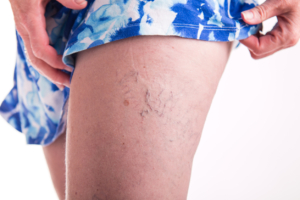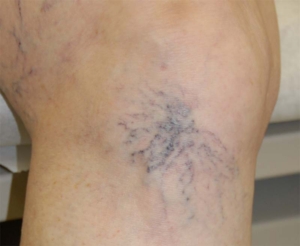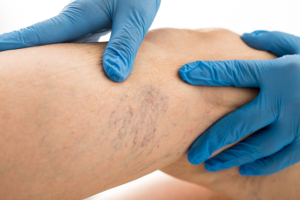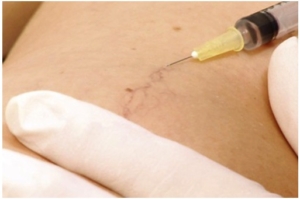Spider veins are very common. So we are often asked if spider veins go away on their own.

The truth is that spider veins on the legs tend to worsen over time in people that have them. They rarely – if ever – go away on their own. The good news, however, is that they can be treated with techniques such as sclerotherapy.
A better understanding of what spider veins are and how they are treated will help understand why they don’t go away on their own, and why they can be treated with techniques such as sclerotherapy.
What are Spider Veins?
Spider veins, also known medically as Telangiectasias, are small veins that lie close to the surface of the skin which appear to be purple, blue or red in appearance. They appear as three basic shapes: linear, branch-like or traditionally in the shape of a spider, with a dark center point. Spider veins most commonly appear on the ankles or thighs, but can appear anywhere on the leg or sometimes the face.
Symptoms of Spider Veins

Many patients do not have symptoms from their spider veins. But symptoms can occur in some patients.
Symptoms of spider veins might include swelling in the lower legs, pain or burning of the affected area, or itching around one or more of the veins.
Occasionally, spider veins can ulcerate and bleed. Prolonged sitting or standing will have a tendency to increase these signs.
Incidence and Causes of Spider Veins
Experts say that nearly 70% of all women will develop some type of venous insufficiency, whether it is in the form of spider veins or varicose veins. They can develop on men as well.

Heredity and hormonal shifts play a major role in the development of spider veins. Weight gain and occupations or activities that require prolonged sitting or standing are also main contributors to venous insufficiency.
Get Rid of Spider Veins with Sclerotherapy
Sclerotherapy is the most common treatment of spider veins. This is a nonsurgical treatment for varicose veins that involves injecting an FDA approved solution into the vein, causing the lining of the vein wall to swell, stick together and ultimately seal shut.
 Once the vein is sealed, the flow of blood is stopped and scar tissue develops in the vein. With the diseased vein sealed, blood is forced into healthier veins. The treated veins are absorbed and eventually becomes nearly invisible.
Once the vein is sealed, the flow of blood is stopped and scar tissue develops in the vein. With the diseased vein sealed, blood is forced into healthier veins. The treated veins are absorbed and eventually becomes nearly invisible.
Sclerotherapy may need to be performed multiple times over the course of weeks or months to achieve the desired results. This is because in most treatment session, not all the spider veins go away. When you meet with the provider you can work with them to assess how many treatment sessions you will need to attempt to achieve the results you are looking for.
Possible Risks & Side Effects:
- A small percentage of patients (10%) may not see an improvement in the appearance of their veins.
- Brown “spots” may appear along the path of the vein, these spots are temporary and very few patients experience any permanent discoloration.
- Blistering, redness, itching, and irritation may develop as a reaction to the adhesive tape used for compression.
- Blistering, infection, ulceration from the injection may develop in some patients. This occurs in less than 1% of the patients.
- An allergic reaction to some of the solutions is a rare possibility.
- Tenderness, bruising, or firmness (especially along the larger vessels) in the treated area may last for varying periods of time. This can be minimized by the use of support hose after the treatment.
- Some people (less than 10%) develop a “matting” or pink blush of the skin, which comes from a temporary enlargement of the tiny capillaries. This is rarely permanent and can be treated.
- Sometimes blood may accumulate in the larger superficial veins treated by sclerotherapy. These accumulations may be treated by the physician to decrease any discomfort. Strict use of support hose minimizes this possibility.
- Rarely, patients can form a clot in the larger deeper veins. The risk of this occurring is much less than 1%.
- People with significant circulatory problem, uncontrolled diabetes or pregnant women should not undergo this procedure.
- Headache or cough can occur just after the treatment session in some patients.
Schedule a Vein Consultation
For more information about spider veins and to learn if treatment might be right for you, fill out our Online Appointment Request Form today!